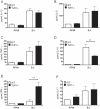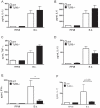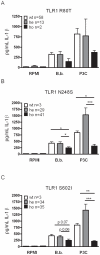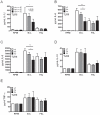TLR1/TLR2 heterodimers play an important role in the recognition of Borrelia spirochetes
- PMID: 21998742
- PMCID: PMC3187844
- DOI: 10.1371/journal.pone.0025998
TLR1/TLR2 heterodimers play an important role in the recognition of Borrelia spirochetes
Abstract
After infection with Borrelia species, the risk for developing Lyme disease varies significantly between individuals. Recognition of Borrelia by the immune system is mediated by pattern recognition receptors (PRRs), such as TLRs. While TLR2 is the main recognition receptor for Borrelia spp., little is known about the role of TLR1 and TLR6, which both can form functionally active heterodimers with TLR2. Here we investigated the recognition of Borrelia by both murine and human TLR1 and TLR6. Peritoneal macrophages from TLR1- and TLR6- gene deficient mice were isolated and exposed to Borrelia. Human PBMCs were stimulated with Borrelia with or without specific TLR1 and TLR6 blocking using specific antibodies. Finally, the functional consequences of TLR polymorphisms on Borrelia-induced cytokine production were assessed. Splenocytes isolated from both TLR1-/- and TLR6-/- mice displayed a distorted Th1/Th2 cytokine balance after stimulation with B.burgdorferi, while no differences in pro-inflammatory cytokine production were observed. In contrast, blockade of TLR1 with specific neutralizing antibodies led to decreased cytokine production by human PBMCs after exposure to B.burgdorferi. Blockade of human TLR6 did not lead to suppression of cytokine production. When PBMCs from healthy individuals bearing polymorphisms in TLR1 were exposed to B.burgdorferi, a remarkably decreased in vitro cytokine production was observed in comparison to wild-type controls. TLR6 polymorphisms lead to a minor modified cytokine production. This study indicates a dominant role for TLR1/TLR2 heterodimers in the induction of the early inflammatory response by Borrelia spirochetes in humans.
Conflict of interest statement
Figures






Similar articles
-
Borrelia burgdorferi basic membrane protein A initiates proinflammatory chemokine storm in THP 1-derived macrophages via the receptors TLR1 and TLR2.Biomed Pharmacother. 2019 Jul;115:108874. doi: 10.1016/j.biopha.2019.108874. Epub 2019 Apr 16. Biomed Pharmacother. 2019. PMID: 31003080
-
The molecular basis for recognition of bacterial ligands at equine TLR2, TLR1 and TLR6.Vet Res. 2013 Jul 4;44(1):50. doi: 10.1186/1297-9716-44-50. Vet Res. 2013. PMID: 23826682 Free PMC article.
-
Lipopeptides are signaled by Toll-like receptor 1, 2 and 6 in endolysosomes.Int Immunol. 2014 Oct;26(10):563-73. doi: 10.1093/intimm/dxu054. Epub 2014 May 24. Int Immunol. 2014. PMID: 24860120
-
Association of TLR1, TLR2, TLR4, TLR6, and TIRAP polymorphisms with disease susceptibility.Immunol Res. 2015 Jun;62(2):234-52. doi: 10.1007/s12026-015-8640-6. Immunol Res. 2015. PMID: 25784622 Review.
-
An Update on Toll-like Receptor 2, Its Function and Dimerization in Pro- and Anti-Inflammatory Processes.Int J Mol Sci. 2023 Aug 5;24(15):12464. doi: 10.3390/ijms241512464. Int J Mol Sci. 2023. PMID: 37569837 Free PMC article. Review.
Cited by
-
The Jarisch-Herxheimer Reaction After Antibiotic Treatment of Spirochetal Infections: A Review of Recent Cases and Our Understanding of Pathogenesis.Am J Trop Med Hyg. 2017 Jan 11;96(1):46-52. doi: 10.4269/ajtmh.16-0434. Epub 2016 Oct 24. Am J Trop Med Hyg. 2017. PMID: 28077740 Free PMC article. Review.
-
Susceptibility to infection with Borrelia afzelii and TLR2 polymorphism in a wild reservoir host.Sci Rep. 2019 Apr 30;9(1):6711. doi: 10.1038/s41598-019-43160-3. Sci Rep. 2019. PMID: 31040326 Free PMC article.
-
Borrelia burgdorferi arthritis-associated locus Bbaa1 regulates Lyme arthritis and K/B×N serum transfer arthritis through intrinsic control of type I IFN production.J Immunol. 2014 Dec 15;193(12):6050-60. doi: 10.4049/jimmunol.1401746. Epub 2014 Nov 5. J Immunol. 2014. PMID: 25378596 Free PMC article.
-
Lizards and the enzootic cycle of Borrelia burgdorferi sensu lato.Mol Microbiol. 2024 Jun;121(6):1262-1272. doi: 10.1111/mmi.15271. Epub 2024 Jun 3. Mol Microbiol. 2024. PMID: 38830767 Free PMC article. Review.
-
Toll-like receptors and chronic inflammation in rheumatic diseases: new developments.Nat Rev Rheumatol. 2016 Jun;12(6):344-57. doi: 10.1038/nrrheum.2016.61. Epub 2016 May 12. Nat Rev Rheumatol. 2016. PMID: 27170508 Review.
References
-
- Burgdorfer W, Barbour AG, Hayes SF, Benach JL, Grunwaldt E, et al. Lyme disease-a tick-borne spirochetosis? Science. 1982;216:1317. - PubMed
-
- Balmelli T, Piffaretti JC. Association between different clinical manifestations of Lyme disease and different species of Borrelia burgdorferi sensu lato. . Res Microbiol. 1995;146:329. - PubMed
-
- Hoshino K, Takeuchi O, Kawai T, Sanjo H, Ogawa T, et al. Cutting edge: Toll-like receptor 4 (TLR4)-deficient mice are hyporesponsive to lipopolysaccharide: evidence for TLR4 as the Lps gene product. J Immunol. 1999;162:3749. - PubMed
Publication types
MeSH terms
Substances
LinkOut - more resources
Full Text Sources
Molecular Biology Databases
Miscellaneous

